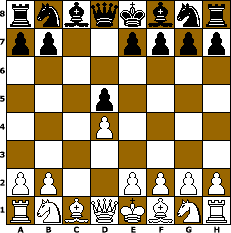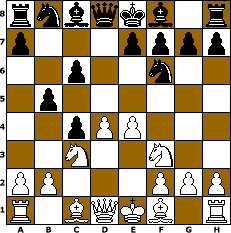The Slav Defense is a chess opening that begins with the moves (in algebraic notation)
- 1.d4 d5
- 2.c4 c6
The Slav is one of the primary defenses to the Queen´s Gambit.
Although it was analyzed as early as 1590, it wasn´t until the 1920s that it started to be explored extensively.
Many masters of Slavic descent helped develop the theory of this opening, including Alapin, Alekhine, Bogoljubov, and Vidmar.
The Slav received an exhaustive test during the two Alekhine–Euwe World Championship matches in 1935 and 1937.
Played by 11 of the first 13 world champions, this defense was particularly favored by Euwe, Botvinnik, and Smyslov.
More recently the Slav has been adopted by Anand, Ivanchuk, Lautier, Short, and other top grandmasters.
Today the theory of the Slav is very extensive and well developed.
General considerations
Black faces three major problems in many variations of the Queen´s Gambit Declined (QGD).
- Development of the Black queen bishop is difficult, as it is often blocked by ...e6.
- The pawn structure offers White targets, especially the possibility of a minority attack on the queenside in the Exchange variation of the QGD.
- White often plays Bg5 to pin the black king knight on f6 against the black queen, and unpinning it is awkward for Black.
The Slav addresses all of these problems.
Black´s queen bishop is unblocked, the pawn structure remains balanced,
and the move Bg5 is not yet threatening as the unmoved black pawn on e7 prevents the pin.
Also, if Black later takes the gambit pawn with ...dxc4, the support provided by the pawn on c6 allows ...b5 which may threaten to keep the gambit pawn or to drive away a white piece that has captured it, gaining Black a tempo for queenside expansion.
On the other side, Black usually won´t be able to develop the queen bishop without first giving up the center with ...dxc4, and moving this bishop may leave the Black queenside weak.
White will try to dominate the center with e2-e4.
Main variations
  
  
The Slav can be entered by many different move orders.
The possibilities include 1.d4 d5 2.Nf3 Nf6 3.c4 c6, 1.Nf3 d5 2.c4 c6 3.d4 Nf6, and so on.
From the standard Slav position (1.d4 d5 2.c4 c6), the most important continuations are
The Slav Exchange Variation takes most of the fun out of the Slav for Black.
After 3.cxd5 cxd5, the symmetrical position offers White only the advantage of the extra move,
but the drawish position offers Black little chance to win unless White is overly ambitious.
To avoid this possibility Black often chooses the move order 2...e6 followed by 3...c6 to enter the Semi-Slav.
Black can also transpose into the Semi-Slav Defense by playing ...e6 on either the third or fourth move.
The Semi-Slav Defense, a kind of a combination Orthodox Defense and Slav Defense,
is a very complex opening in its own right.
See Semi-Slav Defense for details.
After 3.Nc3, the pressure on Black´s center prevents 3...Bf5?, since after 4.cxd5 cxd5 5.Qb3 White wins a pawn.
Another Black try that doesn´t work is 3...Nf6 4.e3 Bf5 5.cxd5 cxd5 6.Qb3 Bc8 and now f4 and Nf3 followed by Ne5 gives White a big advantage.
Black can try the Winawer Countergambit, 3.Nc3 e5, which was introduced in Marshall–Winawer, Monte Carlo 1901,
but usually Black transposes into the Semi-Slav with either 3...e6 or 3...Nf6 4.Nf3 e6.
White´s other knight move is more popular than Nc3.
White can avoid the complexities of the Slav Accepted by entering the Slav Declined with 3.Nf3 Nf6 4.e3.
A common continuation is 4...Bf5 5.cxd5 cxd5. White will try to take advantage of the absence of Black´s queen bishop on the queenside, but this isn´t enough to gain an advantage if Black plays accurately.
The main line continues 3.Nf3 Nf6 4.Nc3.
Black shouldn´t play 4...Bf5 because White will gain the advantage with either 5.Qb3 or 5.cxd5 followed by 6.Qb3.
Traditionally Black had a choice between 4...e6 and 4...dxc4 before developing the queen bishop, but in the 1990s 4...a6 was introduced, with the idea of developing the queenside without locking in the queen bishop or conceding the center.
As before, 4...e6 transposes into the Semi-Slav.
The Slav Accepted continues with 4...dxc4.
White´s sharpest try is the Slav Gambit, 5.e4 b5.
White will usually continue with the Geller-Tolush Gambit, 5.e5 Nd5 6.a4 e6, but it is unclear if the attack is strong enough for the sacrificed pawn.
Evaluation of this line changes as improvements are found, but as of 2005 it is generally thought to favor Black.
White´s other choices in the Slav Accepted are 5.e3 (Alekhine Variation) and 5.a4 (Alapin Variation).
Both moves are popular, with 5.e3 being more solid and 5.a4 being more aggressive.
With 5.a4 White acts against ...b5 and prepares 6.e4 and 7.Bxc4.
Black has many possible responses.
The 5...a6 lines can be tricky. Black prepares to hold on to the gambit pawn with ...b5, and the game may transpose into the complex Meran Variation of the Semi-Slav.
With the Smyslov Variation, 5...Na6, Black intends to gain counterplay by bringing the knight to b4 with 6.e4 Bg4 7.Bxc4 e6 8.0-0 Nb4.
The Czech Variation can be considered the main line.
With 5...Bf5, Black prevents 6.e4.
If White plays 6.e3 (Dutch Variation), play can continue 6...e6 7.Bxc4 Bb4 8.0-0 0-0 with a fairly quiet game.
A more energetic line begins 6.Ne5 (Krause Attack) where White intends f2-f3 and e3-e4 or Nxc4 and followed by a fianchetto of the king bishop with g2-g3 and Bg2.
Black can try either 6...Nbd7 7.Nxc4 Qc7 which may leave White a bit better,
or 6...e6 7.f3 Bb4 when 8.e4 Bxe4 9.fxe4 Nxe4 is a complex piece sacrifice with the possible continuation 10.Bd2 Qxd4 11.Nxe4 Qxe4+ 12.Qe2 Bxd2+ 13.Kxd2 Qd5+ 14.Kc2 Na6.
In the Steiner Variation (also called the Bronstein Variation), 5...Bg4, White may be discouraged from e4 by the possibility 6.e4 e5.
More often the game continues 6.Ne5 Bh5.
References
- Nunn, John (1999). Nunn´s Chess Openings. Everyman. ISBN 1-85744-221-0.
- Burgess, Graham (2000). The Mammoth Book of Chess. Carroll & Graf. ISBN 0786707259.
- Burgess, Graham (2001). The Slav. Gambit. ISBN 1901983447.
- Fine, Reuben (1990). Ideas Behind the Chess Openings. Random House Puzzles & Games. ISBN 0812917561.
|
